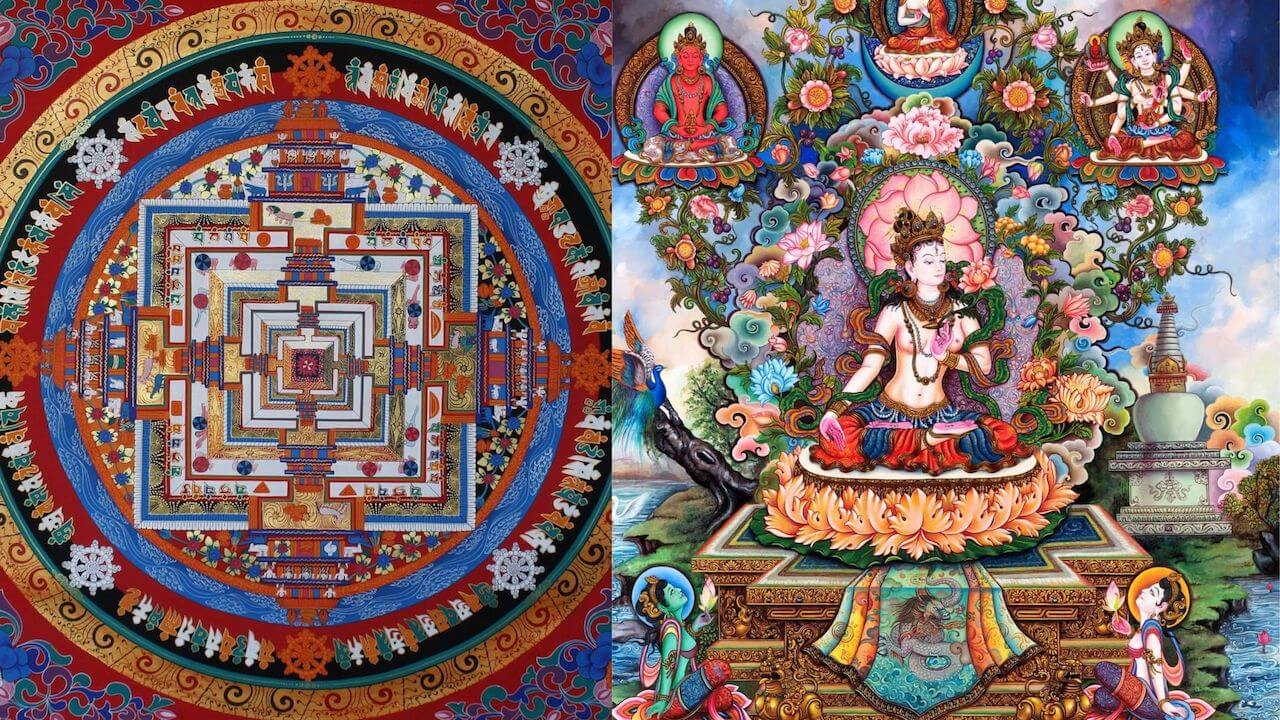Thangka Paintings and its significance
Often spelled as Thanka or Tangka, Thangka Paintings depict multifaceted perspectives of Buddhism. It has the highest significance in Tibetan Buddhism as the form of painting. Unlike others, this unique art form uses cotton sheets or silk embroidery to delineate mandalas. Mandalas being the focal of the painting, Buddhist goddesses, scenes, and other types of Thangka are also well-liked.
Among various purposes, these paintings are primarily used for meditation and teach a set of rules for Buddhist disciples. Meticulously drawn figures with decades of dedication, pinpoint precision of brushes, and enriched depth of knowledge regarding the collection of religious ordinances make it a religiously esteemed, visually appealing, and technically abstruse form of art.

History of Tibetan Art and Origin of Thangka Paintings
The earlier form of Thangka Paintings dates back to 800 BC when the Tang Dynasty ruled China. Their traces reveal that clothes were the only material used to create the painting.
Even today, Mongo Caves in China and Ajanta Caves in India have preserved the remnants of these early paintings.
Buddhism revived in Tibet in the 11th century and fostered the growth of Thangka paintings. Notably, it grew in the places where Buddhism flourished. Hence, the then paintings started delivering a lively sense of origin. Also, they incorporated a particular place’s characteristics, techniques, and fashions of the region.
Before becoming widespread and commercial, for centuries, this form of painting continued to appear on the walls of Tibet.
Types of Thangka Paintings
Materials used, color combination, and techniques adopted for drawing differentiate Thangka. Delineated on clothes, other forms of this painting incorporate silk embroidery. Also, color backgrounds, paper or clothes quality, and gold linings categorize the paintings into different forms.
Mainly, there are three types of Thangka paintings you’ll find.
Life Story of Buddha
Thangka paintings came into life when Buddhism revived in the 11th century in Tibet. Therefore, most forms of these paintings depict Buddha’s life the most.
It presents Buddha’s life from conception, birth, and young age. Moreover, you’ll find the representations of Buddha being a prince and witnessing the sufferings of impecunious peoples. Also, it depicts his abstinence from the royal lifestyle and enlightened phase beautifully.
Some forms of this painting often portray the life of Buddha as Bodhisattva. It’s a state of nirvana before he was born into this world.
The wheel of Life

Wheel of Life artistically outlines the reincarnation of life and the value of our deeds in our existence. It’s the most common form of Thangka you’ll find. They are ubiquitously painted on the walls of Buddhist shrines and on sheets of paper or clothes.
Like a clock, the wheel of life consists of five to six dominions. Each dominion embraces a reborn soul of a person controlled by the tyrant of death, Shinji. These dominions represent the forms of existence and thought processes that determine rebirth based on the Karma of past life. These realms often mirror the genus of our personalities and the circumstances of our lives, greedy as ghostly, gods as pious, hell being incendiary.
Three different components of the wheel of life represent three various insights into Buddhist philosophy. Axle advocates the noble truth of Buddhism, explaining the existence of suffering for misdeeds. Spokes of the wheel split the universe into six dominions. They are humans, gods, demigods, ghosts, animals, and hell. Rim exhibits the white heaven and black hell.
Mandala
Mandala is the most popular Thangka Painting. It is a Tibetan-style paint best for meditational and teaching purposes. Pivotal points in Mandala paintings are for visually aided meditation that kindles meditators’ concentration. Both viewing and painting a Mandala is meditation.

Mandala art delineates three strata. They’re the universe, the path of enlightenment, and the secrets of maintaining a balance between body and mind. The focal point of the mandala paintings is the central deity. The deity, however, varies from one Mandala to another.
The basic architecture of the Mandala has two components: a circle and a square from the inside. This circle represents the shield for protection against damaging forces. The outer circle in flames represents the sign of protection. Lotus petals from the inner circle represent piousness. These lotus petals serve as seats for deities. Specific mandalas represent specific deities.
Materials used and preparations for Thangka Paintings
Thangka paintings are the most decorated forms of paintings with high religious values. Hence, to make them, artists use sophisticated cotton and silk sheets. Also, some Thangka are ornate with 24-carat gold, which makes them alluring and expensive.
Cotton is the most used material over silk embroidery to make this painting. As silk is an expensive sartorial material, using it makes the painting even more lavish. Water-soluble pigments combined with animal glue are the most used paint materials.
Preparations for these paintings are the most essential. The first step involves drawing the foundation for the painting. After the foundation, the artist proceeds with the rituals they need to perform to get purification.
Ultimately, the illustration develops with multiple stages. Based on demanding of the painting, each painting can take a few months to even a year to complete.
Thangka Painting Significance in Buddhism
Thangka Paintings bear Buddhist mantras in the form of inscriptions. The inscriptions are in the shapes of Buddhist stupas and fundamental attributes of Buddhism, meticulously drawn with precise geometric scales. However, it rarely contains information about their owner and the original painter.
A systematic grid of lines and angles aligns body parts like the eye, nose, legs, arms, and nostrils. The deep knowledge of the symbolism of artists captures and creates the liveliness in the painting.
Different Colors
The different colors present different significations in different scenarios. The red color symbolizes fire. Here, the meaning of fire can be the one that inspires you or burns you, based on the nature of the painting. Likewise, the blue color represents the sky, a limitless prospect. Green and Yellow color in the painting symbolizes water and earth.
Buddhism
Thangka paintings are profound in Buddhist symbols and remarks.
The religious bond of this art compels it to follow the exact standards set by the Buddhist scripts. A Thangka artist needs to know more than fine art skills because this form of painting is much more than just art. It is a sacred discipline closely attached to Buddhism.
Therefore, it demands an understanding of Buddhism, formal religious background, and artistic perfection. Nirmanakaya, regarded as the fleshy body of Buddha, is represented by Tibetan thangka and arts. It venerates Buddha as a deity.
Hence, the artist must adhere to the rules in Buddhist scripts. All aspects of the painting like ratio, shape, color composition, and body posture, must follow the principles precisely to epitomize the Buddha or deities of Buddhism.
Thangka Paintings: More than a message
Thangka, in the Tibetan language, is the message. Buddhist practitioners use the implicit messages in the painting for communication. It is a religiously enriched form of art, guided by the rules and standards set by the Buddhist scripts. Thus, it has a rich source of teaching materials for disciples of Buddhism.
Thangka performs several functions in day-to-day life. Firstly, it depicts Buddha’s life, a significant learning source. Secondly, it represents the events in the life of Buddhist Lamas. Also, these paintings well explain the myths and stories regarding the popular deities.
The use of symbols in the paintings also has their purpose and meaning. Treasure vases in any painting typify a long life, better health, and a prosperous life. It also states that religious value never lessens when shared with others.
The victory banner represents the triumph of Buddha over four impediments to enlightenment. They are pride, unpleasant emotions, inclinations, and dread of death. Lotus petals resemble purity, and the lotus bloom depicts Buddha’s eightfold path.
Firstly, emergence from the mud relates to the life cycle. Clean petals on the surface assure purity. And a complete blossom represents the ultimate enlightenment. Other symbols in the painting, such as the various poses of Buddha, indicate compassion, reasoning, meditation, wisdom, purification, etc.
Want to buy Thangka Paintings in Nepal?
Buying Thangka Paintings in Nepal can be a beautiful souvenir. Back home, you can hang it on the wall of your living room or gift it to your loved ones.
While visiting best places in Kathmandu, you’ll find numerous Thangka Painting selling studios. Thamel, Patan, and Boudha Nath Stupa are popular sites to buy Thangka Paintings. Furthermore, you can also visit the Thangka Painting studios for free. You’ll learn about painters meticulously stroke their brushes over the cotton sheet or embroidery.
You can visit some Thangka Stores in Boudha, like Boudha Stupa Thangka Center Pvt. Ltd and Tibet House.


